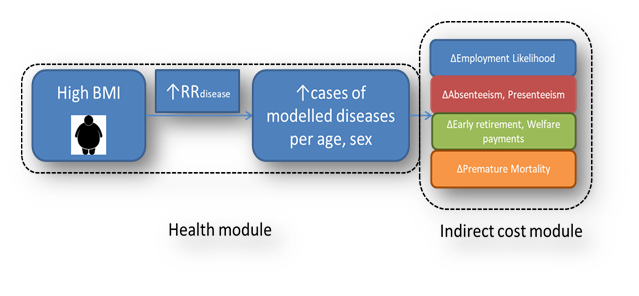5.1. Conceptual framework for the labour market module¶
The labour market module complements outputs from the health module by evaluating how demographic and health conditions affect the following dimensions:
Likelihood of employment
Absenteeism and presenteeism
Welfare costs
Premature mortality.
Each person is assigned specific lifestyles (e.g. alcohol consumption) or risk factors (e.g. a body-mass index value), which are then associated with a specific relative risk for attributable diseases. Based on disease status, each person is assigned a specific employment likelihood, and if working, a certain likelihood/average days of absenteeism and presenteeism at work. Similarly, diseases attributable to specific risk factors will be more positively associated with early retirement, higher welfare payments, and loss to the labour market due to a higher rate of premature mortality (for example, see Fig. 5.1).

Fig. 5.1 Schematic of the labour market module related to BMI¶
Note, in some cases, specific lifestyles (e.g. moderate alcohol use) might be associated with a reduction in the risk of developing certain diseases (e.g. diabetes and heart diseases), as well as being positively associated with employment (but not necessarily causally e.g. due to confounding via a social network effect).
A list of conditions associated with key risk factors, overweight and obesity and alcohol use, can be found in the table below.
Risk factor |
Associated diseases |
|---|---|
Overweight and Obesity |
Ischemic Heart Disease (IHD) |
Diabetes Mellitus (DM) |
|
Cardiovascular Disease (CVD) |
|
Chronic Kidney Disease (CKD) |
|
Low back and neck pain |
|
Hypertensive Heart Disease |
|
Colon and rectum cancer |
|
Esophageal cancer |
|
Liver Cancer |
|
Kidney and Pancreatic Cancer |
|
Alcohol |
Cirrhosis |
Alcohol Use disorder |
|
Road and unintentional injuries |
|
Self-harm |
|
Liver Cancer, Breast Cancer |
|
CVD |
|
Nasopharynx & Esophageal Cancer |
|
IHD* |
|
DM* |
Note: This table highlights the conditions that contribute 95% of the overweight/obesity – and alcohol related disease burden in all EU countries and Iceland, Switzerland, and Norway. The table further indicates which of these conditions are currently modelled and implemented in the OECD microsimulation model, and whether these conditions are included in the SHARE questionnaires. In future iterations of the OECD microsimulation model, at least data for pancreatic cancer and updated date on Alcohol Use Disorder (AUD) will be included. * Moderate alcohol use can be protective of Ischaemic Heart Disease (IHD) and Diabetes Mellitus (DM). Source: OECD analysis of [GBD 2016 Disease and Injury Incidence and Prevalence Collaborators et al., 2017 [72]].
